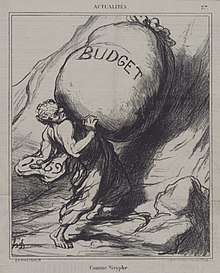Budget
A budget is a financial plan for a defined period, often one year. It may also include planned sales volumes and revenues, resource quantities, costs and expenses, assets, liabilities and cash flows. Companies, governments, families and other organizations use it to express strategic plans of activities or events in measurable terms.[1]
| Part of a series on |
| Accounting |
|---|
 |
|
Major types |
|
Selected accounts |
|
Accounting standards
|
|
|
|
People and organizations
|
|
Development |
A budget is the sum of money allocated for a particular purpose and the summary of intended expenditures along with proposals for how to meet them. It may include a budget surplus, providing money for use at a future time, or a deficit in which expenses exceed income.

Etymology
A budget (derived from the old French word meaning purse) is a quantified financial plan for a forthcoming accounting period.[2]
A budget is an important concept in microeconomics, which uses a budget line to illustrate the trade-offs between two or more goods. In other terms, a budget is an organizational plan stated in monetary terms.
In summary, the purpose of budgeting tools is to:
- Provide a forecast of revenues and expenditures. This is achieved by constructing a model of how a business might perform financially if certain strategies, events and plans are carried out.
- Enable the actual financial operation of the business to be measured against the forecast.
- Establish the cost constraint for a project, program, or operation.
Corporate
The budget of a company is often compiled annually, but may not be a finished budget, usually requiring considerable effort, is a plan for the short-term future, typically allows hundreds or even thousands of people in various departments (operations, human resources, IT, etc.) to list their expected revenues and expenses in the final budget.
If the actual figures delivered through the budget period come close to the budget, this suggests that the managers understand their business and have been successfully driving it in the intended direction. On the other hand, if the figures diverge wildly from the budget, this sends an 'out of control' signal, and the share price could suffer. Campaign planners incur two types of cost in any campaign: the first is the cost of human resource necessary to plan and execute the campaign. The second type of expense that campaign planners incur is the hard cost of the campaign itself.
Government
The budget of a government is a summary or plan of the intended revenues and expenditures of that government. There are three types of government budget : the operating or current budget, the capital or investment budget, and the cash or cash flow budget.[3]
United Kingdom, Canada, Australia and New Zealand
United States
The federal budget is prepared by the Office of Management and Budget, and submitted to Congress for consideration. Invariably, Congress makes many and substantial changes. Nearly all American states are required to have balanced budgets, but the federal government is allowed to run deficits.
India
The budget is prepared by the Budget Division Department of Economic Affairs of the Ministry of Finance annually. The Finance Minister is the head of the budget making committee. The present Indian Finance minister is Nirmala Sitharaman. The Budget includes supplementary excess grants and when a proclamation by the President as to failure of Constitutional machinery is in operation in relation to a State or a Union Territory, preparation of the Budget of such State.
The first budget of India was submitted on 18 February 1860 by James Wilson. P C Mahalanobis is known as the father of Indian budget.
Philippines
The Philippine budget is considered the most complicated in the world, incorporating multiple approaches in one single budget system: line-item (budget execution), performance (budget accountability), and zero-based budgeting. The Department of Budget and Management (DBM) prepares the National Expenditure Program and forwards it to the Committee on Appropriations of the House of Representatives to come up with a General Appropriations Bill (GAB). The GAB will go through budget deliberations and voting; the same process occurs when the GAB is transmitted to the Philippine Senate.
After both houses of Congress approves the GAB, the President signs the bill into a General Appropriations Act (GAA); also, the President may opt to veto the GAB and have it returned to the legislative branch or leave the bill unsigned for 30 days and lapse into law. There are two types of budget bill veto: the line-item veto and the veto of the whole budget.
Personal or family
A personal budget or home budget is a finance plan that allocates future personal income towards expenses, savings and debt repayment. Past spending and personal debt are considered when creating a personal budget. There are several methods and tools available for creating, using and adjusting a personal budget. For example, jobs are an income source, while bills and rent payments are expenses. A third category (other than income and expenses) may be assets (such as property, investments or other savings or value) representing a potential reserve for funds in case of budget shortfalls.
There are many informational sites and software available for use in personal and family problems.
Event management
A budget is a fundamental tool for an event director to predict with a reasonable accuracy whether the event will result in a profit, a loss or will break-even.
There are two basic approaches or philosophies, when it comes to budgeting. One approach is telling you on mathematical models, and the other on people.
The first school of thought believes that financial models, if properly constructed, can be used to predict the future. The focus is on variables, inputs and outputs, drivers and the like. Investments of time and money are devoted to perfecting these models, which are typically held in some type of financial spreadsheet application.
The other school of thought holds that it's not about models, it's about people. No matter how sophisticated models can get, the best information comes from the people in the business. The focus is therefore in engaging the managers in the business more fully in the budget process, and building accountability for the results. The companies that adhere to this approach have their managers develop their own budgets. While many companies would say that they do both, in reality the investment of time and money falls squarely in one approach or the other.
Types
- Sales budget – an estimate of future sales, often broken down into both units. It is used to create company and sales goals.
- Production budget - an estimate of the number of units that must be manufactured to meet the sales goals. The production budget also estimates the various costs involved with manufacturing those units, including labour and material. Created by product oriented companies.
- Capital budget - used to determine whether an organization's long-term investments such as new machinery, replacement machinery, new plants, new products, and research development projects are worth pursuing.
- Cash flow/cash budget – a prediction of future cash receipts and expenditures for a particular time period. It usually covers a period in the short-term future. The cash flow budget helps the business to determine when income will be sufficient to cover expenses and when the company will need to seek outside financing.
- Conditional budgeting is a budgeting approach designed for companies with fluctuating income, high fixed costs, or income depending on sunk costs, as well as NPOs and NGOs.
- Marketing budget – an estimate of the funds needed for promotion, advertising, and public relations in order to market the product or service.
- Project budget – a prediction of the costs associated with a particular company project. These costs include labour, materials, and other related expenses. The project budget is often broken down into specific tasks, with task budgets assigned to each. A cost estimate is used to establish a project budget.
- Revenue budget – consists of revenue receipts of government and the expenditure met from these revenues. Tax revenues are made up of taxes and other duties that the government levies.
- Expenditure budget – includes spending data items.
- Flexibility budget - it is established for fixed cost and variable rate is determined per activity measure for variable cost.
- Appropriation budget - a maximum amount is established for certain expenditure based on management judgment.
- Performance budget - it is mostly used by organization and ministries involved in the development activities. This process of budget takes into account the end results.
- Zero based budget - A budget type where every item added to the budget needs approval and no items are carried forward from the prior years budget. This type of budget has a clear advantage when the limited resources are to be allocated carefully and objectively. Zero based budgeting takes more time to create as all pieces of the budget need to be reviewed by management.
- Personal budget - A budget type focusing on expenses for self or for home, usually involves an income to budget.
References
- "CIMA Official Terminology" (PDF). Archived from the original (PDF) on 2013-08-10.
- O'Sullivan, Arthur; Sheffrin, Steven M. (2003). Economics: Principles in Action. Upper Saddle River, New Jersey 07458: Pearson Prentice Hall. pp. 502. ISBN 0-13-063085-3.CS1 maint: location (link)
- Cliche, P. (2012). “Budget,” in L. Côté and J.-F. Savard (eds.), Encyclopedic Dictionary of Public Administration, [online], http://www.dictionnaire.enap.ca/Dictionnaire/en/home.aspx
External links
| Library resources about Budgets |



- Origin of the word